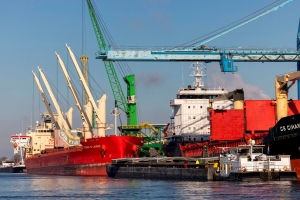


(Posted on 14/04/22)
Sea freight cargo traffic at North Sea Port increased by more than 6% during Q1 2022. The consequences of the pandemic are being steadily rolled back, however, the EU sanctions against Russia are not yet being reflected in cargo traffic. Trade with Ukraine is also still being maintained.
In the first quarter of 2022, the companies in North Sea Port recorded 17.7 million tons of goods traffic via sea freight. This is an increase of 6.2% compared to the same period in 2021, during the pandemic.
Since the low point of the Covid crisis in the third quarter of 2020, maritime cargo throughput has continued to rise quarter after quarter. The sanctions on Russia had no effect on traffic during the first quarter of 2022. Trade with Ukraine also remained stable.
In the first quarter of 2022, dry bulk, general cargo and ro/ro did well compared to the same quarter last year. Dry bulk transshipment (9.4 million tons, +11.6%) experienced a fourth strong quarter in a row with iron ore as the main product. Conventional general cargo (2.6 million tons, +5.4%) is also on the rise, thanks to cellulose among others. The volume of ro/ro transport (1 million tons, +15.8%) is also increasing. The share of liquid products (4.1 million tons of goods, -3.8%) is decreasing as is that of containers (0.5 million tons, -9.8%).
Goods traffic via inland shipping is continuing its growth with the best quarter in history. North Sea Port registered 16.2 million tons of goods shipped via inland shipping.
The first quarter of 2022 is showing continued recovery, both in sea freight and inland shipping.
For a year now, step by step, a recovery can be noted as far as the effects of the Covid crisis are concerned. After one quarter, seaborne cargo throughput only has to catch up just over one percent to rival the level of the record year 2019. This is expected to be the case by late 2022.
This quarter has not yet reflected the EU sanction policy against Russia or trade with Ukraine. This is expected to become visible during the second or third quarter as the sanctions are ramped up. The result then may be a decrease in cargo throughput because of lower trade or lack of trade with Ukraine and Russia.
Euroports has announced the renewal of the concession for Terminal Rinfuse Venezia (TRV) at Porto Marghera... Read more
Contributing to the commitment of achieving net zero emissions by 2050, the Panama Canal authority has... Read more
The Saguenay Port Authority in Quebec has ordered a Konecranes Gottwald ESP.6B Mobile Harbor Crane for... Read more
North Sea Port Supervisory Body has appointed Cas König as the port authority's new CEO. Kö... Read more
After 19 years at the helm of the Port of Trois-Rivières and a career rich in major projects,... Read more
Abu Dhabi based AD Ports Group, an enabler of integrated trade, transport and logistics solutions, has... Read more
The Port of Rotterdam and Port of Antwerp-Bruges have welcomed the Clean Industrial Deal, through which... Read more
The Canadian Port of Trois-Rivières is delighted to have received major funding of $87.1 million... Read more
Belgian logistics giant Katoen Natie has ordered four all-electric Konecranes Gottwald Mobile Harbor... Read more
AD Ports Group, Abu Dhabi based enabler of integrated trade, transport and logistics solutions, has... Read more